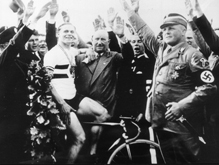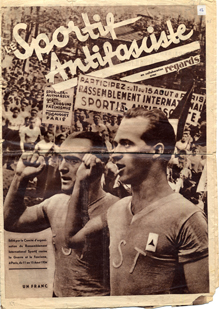
Albert Richter, Illustrierter Radrenn-Sport. July 20th 1934. After a race, Albert Richter (1912-1940) pointedly rests his hand on his thigh, rather than perform the Nazi salute for the official photograph. He was one of the greatest racing cyclists in interwar Germany. While the Nazi machine was increasing its hold over Germany, Richter remained faithful to his Jewish trainer, Ernst Berliner (at his left on the image), and took all manner of risks to help him. Richter was found dead on January 3rd 1940. Coll. Renate Franz.

Le Sportif antifasciste. France, 1934. Newspaper of the Comité d’organisation du rassemblement international sportif contre le nazisme et le fascisme (Committee to organise an international sporting collective against Nazism and fascism). Coll. Musée de la Résistance
Book our events online
Resistance in sport;
resistance through sport
The athlete of the Reich must embody the ideal portrait of the Aryan as it was conceived the Nazi regime: the heir of both the ancient heroes and the modern athlete.
In this context the practice of sport, far from being synonymous with personal development and entertainment, implies for the Nazi ideology discipline, training, and mentoring of the bodies, according to the famous slogan "your body is not yours, it belongs to the Führer. "However, athletes and even champions, often isolated, have managed to somehow resist the influence of the totalitarian regime. Neither anti-Nazi politically or intellectually engaged, Albert Richter and Max Schmeling enjoy glory and success but refuse to embody the Aryan model and to be used by the regime's propaganda. They do not join the Nazi party, despite strong pressure and threats becoming more explicit. When the regime strengthens the anti-Semitic measures, they refuse to send back their Jewish Jewish and multiply acts of braveness and dissidence. They will pay a heavy price for this insubordination.
Authorized sporting activities were used as a front for Resistance organizations. Sporting excursions also provided cover for Resistance activity, and stadium crowds provided cover for their combatants. Sport Libre, founded in 1941 by Robert Mension and Auguste Delaune,was the only example of a clandestine sports group in France: it illustrates the contribution made by workers' sports to the Resistance struggle, and more specifically, an extension into the stadium of communist resistance action.
Sport, particularly in the form of physical education, is a source of energy and mental strength. For example, members of the maquis used it to keep fit, and prepare for combat.
It seems sport could be used as an act of defiance in the most extreme situations. In this spirit, French swimming champion Alfred Nakache and the young Noah Klieger swam in an Auschwitz water tank without their captors realizing: a way to prove they hadn't been stripped of all humanity, and to give courage to their unfortunate companions. Next >>
quizz Quel est le nom du mouvement de résistance sportif clandestin français?
« Sport Libre »
Robert Uhrig
